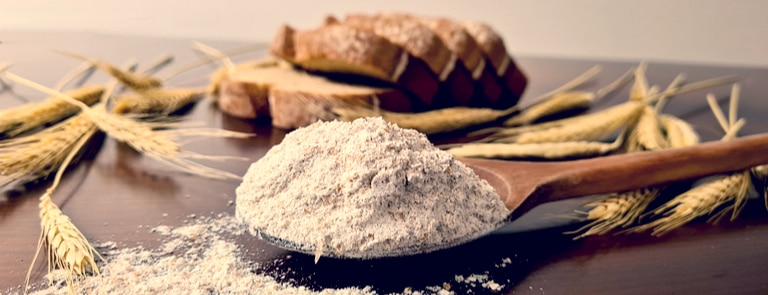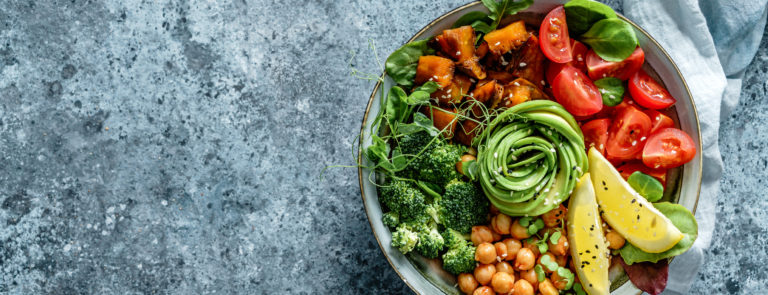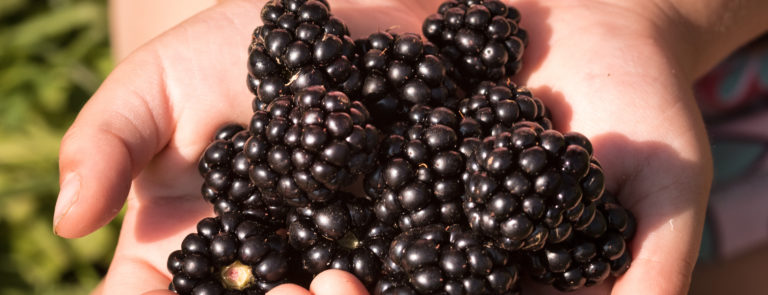20% off €35
What is rye flour?

Rye flour is made from ground rye berries, which are also known as whole rye kernels.
A close relative of both wheat and barley, rye berries are a cereal grain grown across the world, particularly in Europe and Russia.
Rye flour is used to make rye bread, sourdough bread, crackers, gingerbread, crispbreads, fruitcakes, scones, pasta, as well as a filler for soups, sauces and pancake flour in the USA.1
Rye flour imparts a sour, nutty taste to baked goods, including the popular rye bread sourdough loaf.
How is rye flour made?
Rye berries are small, hard, starchy nut-like kernels. It’s these rye berries which are ground to make rye flour.
Before milling, the tough, inedible outer part of the rye berry – the hull - is removed.
Rye flour can range in colour from white to dark brown. The colour of rye flour is a result of the milling process, as follows:2,3
White rye flour – The bran layer and germ have been removed prior to milling, leaving behind only the white endosperm. The flour is off-white in colour.
Medium rye flour – The bran layer and some of the germ have been removed, leaving behind the endosperm and some of the germ. Medium rye flour is a pale coffee cream colour.
Dark rye flour –The bran layer has been removed leaving the endosperm and germ behind, as well as some of the bran. Also known as wholemeal rye flour.
Pumpernickel flour – This type of flour contains the endosperm, the germ and the bran. A coarser, whole grain flour.
Is rye flour gluten free?
No. Rye flour contains the protein gluten, making it unsuitable for those following a gluten-free diet.
Can coeliacs eat rye flour?
No, as rye flour contains gluten – the allergen in coeliac disease – people with coeliac disease should not eat products containing rye flour.4
Is rye flour good for baking?
Rye bread flour is an excellent flour to bake with, but it is important to bear in mind that it behaves differently in recipes to wheat flour.
For example, you may have noticed that sourdough and rye breads are much heavier and more compact than wheat flour bread.
They don’t have that springy rise and spongey texture. This is to do with the type of gluten rye flour contains.
Gluten goes sticky when water is added, transforming into a stretchy, pliable dough. When combined with yeast and baked, gluten forms tiny gas pockets, which inflate and harden, giving structure and springiness to bread (think of a freshly baked baguette).5
Rye flour does contain gluten but contains less glutenin than wheat flour. Glutenin is key to forming strong gluten bonds, which are needed to create a stretchy dough.
In the absence of enough glutenin, rye flour gluten doesn’t create the large pockets of gas in the crumb that we see with wheat flour. The result is a smaller, denser loaf.6
Another reason rye flour creates more compact bakes is to do with the enzymes in rye flour – known as amylases – which break down rye’s starch during the baking process.7
The loaves of rye bread and rye sourdough you see in shops and bakeries often contain a larger percentage of wheat flour than rye flour. The wheat flour is added to give the bread a more substantial, springy crust and paler colour.
In some countries, such as Germany and Russia, bread made with 100% rye flour is common.
Traditional rye bread contains whole rye berries along with rye flour, as well as rolled rye flakes.
Just like with brown bread or rice, the bran is where most of the nutrients lie. So, the paler rye flours are less nutrient-dense than their darker counterparts.8
Is rye flour the same as wheat flour?
Rye flour has its own characteristics, making it different from wheat flour. It’s generally darker (apart from white rye flour), it has a nuttier, earthier flavour, and doesn’t rise in baking the way wheat flour does.
A blend of both rye and wheat flours are usually used for breadmaking to ensure the bread rises and has good texture.
Does rye flour take longer to bake?
Rye bread doesn’t generally need to be baked for longer. 30 – 35 minutes is the usual recommended baking time – the same as a white wheat loaf.
However, dough made with rye flour does take longer to prove. You might need to leave rye dough for at least eight hours to double in size.
Is rye easier to digest than wheat?
Fibre-rich rye promotes healthy bowel movements and moves through your digestive tract faster than wheat. As a result, less bile is created, which is easier on the stomach.9
Rye has more fibre than wheat flour (rye flour has 16g fibre per 100g, compared to 2.4g per 100g in wheat flour), so the digestive benefits are greater with rye.
Add high-fibre foods to your diet slowly if you’re not used to them, to avoid causing temporary digestive discomfort.
Summary
- Rye flour is made from ground rye berries
- It comes in various varieties – white, medium, dark and pumpernickel
- Rye flour contains some gluten – so it’s unsuitable for coeliacs
- Rye flour doesn’t rise like wheat flour in baking – so a blend of rye and wheat is usually used
- It’s great for digestion thanks to the fibre it contains
Is rye good for health?
Now we know what rye flour is all about, let's get on to the all-important question: is rye healthy?
8 health benefits of rye flour
Rye flour is a great choice for those looking to incorporate more fibre-rich whole grains into their life.
It’s a source of soluble and insoluble fibre, B vitamins (including folate and choline), copper, manganese, iron, magnesium and zinc.10
Further rye bread health benefits include:
-
It can help you lose weight
The fibre content in rye flour makes it satiating (filling) – meaning you’ll be satisfied after eating and won’t be searching for snacks soon after.
Further, the insoluble fibre in rye flour offers bulk to your stool and increases intestinal transit time – which reduces constipation and can help with weight loss.11
-
It can lower your risk of developing type 2 diabetes
Not only do products containing rye flour help protect against obesity (see above) – a key risk factor in the development of type 2 diabetes – they can help reduce rapid raises in blood glucose, which in itself is a type 2 diabetes risk factor.12
-
It helps promote good gut health
The soluble fibre and fructans in rye flour provide friendly bacteria for the large intestine, which ensures a balanced gut microbiome. A healthy gut is thought to positively affect the whole body – from inflammation levels to mood.
-
It can help control blood sugar
Levels of blood glucose are known to stay more stable following rye flour foods than with those containing wheat flour. This is thought to be because the starches in rye flour stay in the stomach for longer than those in wheat, delaying gastric emptying and the subsequent release of glucose into the blood.13
-
It can help protect against cardiovascular disease
Consumption of whole grain foods, such as rye bread, is known to reduce the risk of developing various diseases, including cardiovascular diseases (such as heart attacks and stroke).14
-
It doesn’t cause inflammation
The insulin released when we eat a refined carbohydrate such as wheat flour can trigger an inflammatory response in the body. Inflammation is a contributing factor to various diseases.
Whole grain rye has lower inflammatory biomarker concentration than refined wheat, making it a great choice for all-round health.15
-
It can help lower your cholesterol
Some rye foods appear to have cholesterol-lowering properties.
Research is ongoing, but one study has found that rye products can reduce LDL (bad) cholesterol by 6% after 12 weeks compared with refined wheat. This is a cholesterol-lowering effect in line with that of oats.16
-
It can help protect against disease
Rye flour contains plenty of bioactive compounds in the form of phytochemicals, which are known to be protective against various diseases.
One such phytochemical in rye is lignans. A high intake of lignans in the diet correlates with a reduced risk of developing breast cancer.17
How does rye flour compare to other flours?
Here is how rye flour's nutritional value compares to other popular flours.18,19,20,21
| Flour (100g) | Energy | Fat | Carbs | Sugar | Fibre | Protein | Iron |
|---|---|---|---|---|---|---|---|
| Rye (dark) | 325kcal | 2.2g | 69g | 2.3g | 24g | 16g | 4.97mg |
| Almond | 571mg | 50g | 21g | 7.1g | 14g | 21g | 3.57mg |
| White wheat | 364kcal | 1g | 76g | 0.3g | 2.7g | 10g | 1.17mg |
| Whole grain wheat | 340kcal | 2.5g | 72g | 0.4g | 11g | 13g | 3.6mg |
| Semolina | 357kcal | 1.2g | 74g | 2.4g | 4.8g | 12g | 3.43mg |
| Buckwheat | 335kcsl | 3.1g | 71g | 2.6g | 10g | 12g | 4.07mg |
| Brown rice | 363kcal | 2.8g | 76g | 0.7g | 4.6g | 7.2g | 1.98mg |
| White rice | 359kcal | 1.3g | 80g | 0.1g | 0.5g | 6.9g | 0.22mg |
| Coconut | 400kcal | 13g | 60g | 20g | 33g | 20g | 6.67mg |
| Tapioca | 349kcal | 0.2g | 85g | 3.5g | 0g | 0.6g | 1mg |
| Soya (defatted) | 330kcal | 1.2g | 38.4g | 18.9g | 17.5g | 47g | 9.2mg |
| Corn | 361kcal | 3.9g | 76.8g | 0.6g | 7.3g | 6.9g | 2.4mg |
| Quinoa | 368kcal | 7.5g | 69g | 3.6g | 7g | 10g | 4.8mg |
Can rye flour go bad?
Whole grain flours like rye contain more oil than wheat flour, so spoil quicker.22
Rye flour stays at its best around 3 months in the pantry, and 6 months in the freezer.23 It’s advisable to keep rye flour in the fridge to prolong its shelf life.
Summary
- Rye flour is high in fibre, iron, magnesium, manganese, copper and B vitamins
- Rye flour can help you feel fuller for longer, key to losing weight
- It can help reduce your risk of diseases including type 2 diabetes, cardiovascular disease and even some cancers
- Rye flour can help lower both inflammation and bad cholesterol in the body
Last updated: 04 May 2021
- https://www.sciencedirect.com/topics/food-science/rye-flour
- https://wholegrainscouncil.org/whole-grains-101/grain-month-calendar/rye-triticale-august-grains-month/types-rye
- https://sunnybrook.ca/content/?page=occ-prevention-pv-ync-plantbaseddiet-howto
- https://www.coeliac.org.uk/information-and-support/living-gluten-free/the-gluten-free-diet/about-gluten/grains/
- https://www.exploratorium.edu/cooking/bread/bread_science.html
- https://healthyeating.sfgate.com/gluten-content-flours-11162.html
- https://www.sciencedirect.com/topics/food-science/rye-flour
- https://wholegrainscouncil.org/whole-grains-101/whole-grains-101-orphan-pages-found/health-benefits-rye
- https://www.lybrate.com/topic/rye-benefits-and-side-effects
- https://www.whfoods.com/genpage.php/
- https://www.sciencedirect.com/science/article/pii/S0924224418303339
- https://www.sciencedaily.com/releases/2018/07/180724174233.htm
- https://pubmed.ncbi.nlm.nih.gov/2436870/
- https://www.bmj.com/content/353/bmj.i2716
- https://www.sciencedirect.com/science/article/pii/S0924224418303339
- https://www.sciencedirect.com/science/article/pii/S0924224418303339
- https://www.ncbi.nlm.nih.gov/pmc/articles/PMC3037245/
- https://www.nutritionvalue.org/Rye_flour/.
- https://www.nutritionvalue.org/Rice_flour%2C_brown_nutritional_value.html
- https://nutritiondata.self.com/facts/legumes-and-legume-products/4384/2
- https://www.fatsecret.co.uk/calories-nutrition/holland-barrett/quinoa-flour-power/100g
- https://www.doesitgobad.com/does-flour-go-bad/
- https://wholegrainscouncil.org/recipes/cooking-whole-grains/storing-whole-grains



